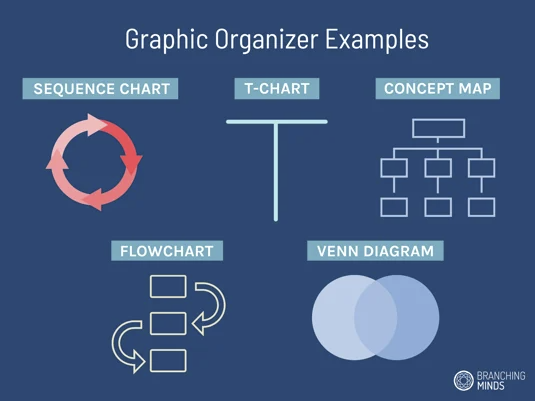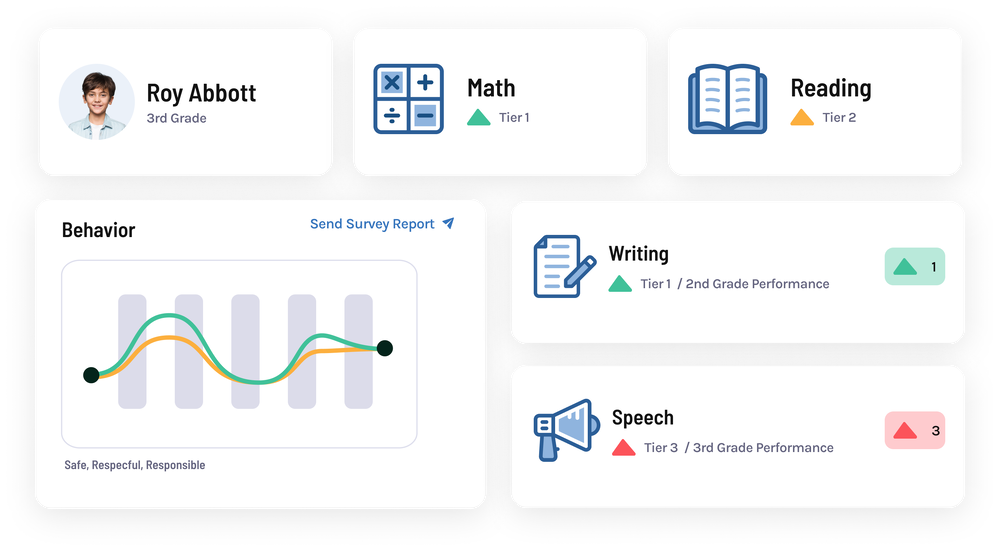Practical Reading Comprehension for Secondary Students Takeaways
- At the secondary level, reading comprehension across content areas can be a challenge for students not reading at grade level.
- There are practical strategies that secondary teachers can use to differentiate instruction and make written content more accessible for struggling students.
- Reading strategies can be implemented easily within the ongoing curriculum.
According to the Nation's Report Card, only 34% of 8th-grade students read at grade level.
As a middle school language arts teacher, I was often called upon by other teachers to help them with struggling students. The issue might have been independent work, grasping material, or meeting written response expectations. I knew most of the struggle was rooted in students' inability to read grade-level texts independently. My department was often tasked with providing resources for the whole building to help students in all subject areas. The question at the front of our minds was… “What can our science, math, and social studies teachers do to help students understand written material when students can’t read and comprehend grade-level text?”
The good news is that research on reading at the middle and high school levels identifies strategies to help secondary teachers and students. This article will outline a few practical ways content area teachers can support students with reading.
What’s the Difference Between Learning Supports/Strategies and an Intervention?
- Learning supports and strategies are resources founded on research used to complement Tier 1 core instruction.
- An intervention is an evidence-based resource that targets a specific skill for a certain length of time, and is routinely measured for effectiveness.
The Importance of Differentiated and Accessible Core Instruction
The Multi-Tiered System of Supports (MTSS) framework is designed to give all students the help they need. A central tenet of MTSS is differentiated, solid core instruction for all students at Tier 1. This begins with providing learning supports and strategies within Tier 1 to differentiate for all types of learners. The right strategy paired with core instruction can help a struggling reader get past the comprehension barrier in any class—not all students learn the same way or at the same pace.
Here are a few research-based reading strategies that secondary teachers can implement to help students struggling with reading, no matter the content area, along with a few ideas on how to implement them easily.
1. Graphic Organizers
At any level and in any content area, teachers can use graphic organizers to support students in comprehension. For example, when tackling new information within a complex text, a graphic organizer provides structure and organization to the information, increasing accessibility for students.
Jennifer Gonzalez of Cult of Pedagogy says, “Presenting information in both text and graphic formats is one of the most basic ways to make a lesson accessible to more students—the basis of Universal Design for Learning—and graphic organizers definitely fit the bill there” (Gonzales 2017). Many research studies have been conducted about graphic organizers’ effectiveness in helping students with language development, science, and writing instruction, along with assisting students with disabilities.
Ideas for Implementing
- Compare/Contrast: Using a Venn diagram helps break down and classify differences.
- Tables/Charts: Giving notes or categorizing information using tables or charts helps organize studying.
- Images: Provides visual associations for memory and understanding.
- Brainstorming Mapping: This could be a pre-writing strategy or for students to make connections between ideas.
It's a simple switch to translate materials into a graphic organizer or create one for students. There are plenty of websites to create your own, such as https://graphicorganizer.net/.

2. Provide Background and Activate Prior Knowledge
In our diverse education system, students have varying life experiences and exposure to ideas. When teaching a text that assumes a level of background or understanding that may be lacking, it’s essential to provide that background knowledge or activate the students' prior knowledge related to the content. Research has shown that doing so will increase comprehension.
“Activating one’s prior knowledge of a topic before reading provides a mental “hook” linking knowledge the reader already possesses with ideas in the text.” (Neufeld, 2011) Making connections in the brain is essential for understanding and recall, kind of like building a mental file cabinet to sort and store information. This strategy will ultimately promote a deeper understanding and comprehension of the text they are about to read.
Ideas for Implementing:
- Utilize a historical video to establish some background knowledge.
- Take a virtual reality field trip to an unfamiliar setting for students.
- Bring in a subject matter expert to introduce a topic.
- Have an artifact discovery session with related materials.
3. Active Reading with Annotation
Interacting with a text while reading can be difficult for some students. Using the Active Reading strategy, students make notes to help them engage and comprehend what they are reading. Learning to take notes while reading helps students make connections and keep track of their questions and unknown vocabulary.
Research has shown that an active reading strategy can help improve students’ reading comprehension skills. Interacting with the text helps students make the words meaningful and thus aids in comprehension.
There are many ways to implement this strategy, whether through signs and symbols or methods such as Notice and Note by Beers and Probst, a KWL chart, or even close reading symbols.
Ideas for Implementing:
- Use a copy of the text that the student can write on or highlight.
- Model how to take notes in the margins while reading with a displayed copy of the text.
- While reading, stop to answer questions students may have, define any unknown words or phrases.
- Make connections to other material from the content or other content areas.
4. Pre-Teach New and Important Concepts
For some students, it can help to pre-teach a concept before a lesson; this means they get a preview of these required skills in a small group or one on one before the entire class. This strategy improves their chances and reduces their stress during the lesson.
The research indicates that this specific strategy is excellent for students struggling with math achievement and students that have a low academic self-concept with math achievement. The same applies to other content areas as well. Teachers providing a preview or review of essential concepts before lessons can give confidence to those students who might struggle with understanding the material. This strategy can make all the difference to a child who needs several passes before they grasp an idea.
Ideas for Implementing
- Begin by identifying key skills within a lesson or unit.
- Give a short preview or resource to help them preview those skills with a small group of students or the whole class.
- Use activities or short video introductions prior to the lesson.
- Provide a database or online access to videos for students looking ahead in the semester.
5. Vocabulary Instruction and Word Maps
Lastly, explicitly teaching content-specific vocabulary prior to and during interaction with a text has a direct positive impact on reading comprehension. “When students understand the words they read and have strategies to figure out unknown words, they can make greater gains in understanding the meaning of what is being read,” (Marchand-Martella et al., 2013, 169). It seems obvious, doesn’t it? But at the secondary level, teachers across all content areas may need training and reminders to be intentional about teaching vocabulary.
This great article from the Texas Center for Learning disabilities lays out several important factors in effective vocabulary instruction:
- Vocabulary instruction must be explicit, with clear definitions, examples, and non-examples.
- Students need many practice opportunities over time and in several formats.
- Every subject has key vocabulary words that should be carefully identified and taught. Time is limited, so choose words that are foundational and used often.
The research on language learning indicates that students can also improve their vocabulary re and reading comprehension with visuals like a word map. A word map can work in several ways, but essentially it is a graphic organizer with four boxes at the center (or top) where you write the word. The other boxes are for definitions, synonyms, using the word in a sentence, or pictures to describe the word.
Organizers like this help build knowledge around the word and possibly represent new information for understanding.
Ideas for Implementing
- Develop a vocabulary routine to introduce new content-specific words.
- Teach common morphemes—prefixes, roots, and suffixes—to help students decipher unfamiliar words.
- Allow students to design a word map.
- Utilize word walls with pictures for classroom display and further learning.
Small Changes Can Help Scaffold Support
It can often feel like the gap between “where students are” and “where we want them to be” is too big to overcome. But, strategies that scaffold the student for understanding and organizing content can remove barriers to success and start closing those reading gaps.
Within the MTSS framework, support for struggling readers is built on solid Tier 1 Core Instruction and begins with small changes in how teachers differentiate and make their curriculum accessible to all students.
These reading support strategies are just a snapshot of ways a teacher might differentiate their instruction, but they are a start. Don’t underestimate the power of simple instructional strategies in making content accessible to all learners!
These featured strategies just scratch the surface of the interventions and learning supports available to teachers. Consider expanding your knowledge by:
- Learning more about the Branching Minds Intervention Library and MTSS platform by scheduling a demo. Each intervention and support in the BRM Library is evaluated using the ESSA Tiers of Evidence and includes research and resources to help with implementation.
Resources For Using MTSS at the Secondary Level
Sources
Gonzales, J. (2017, October 22). The Great and Powerful Graphic Organizer. Cult of Pedagogy. Retrieved August 29, 2022, from https://www.cultofpedagogy.com/graphic-organizer/
Marchand-Martella, N. E., Martella, R. C., Modderman, S. L., Petersen, H., & Pan, S. (2013). Key Areas of Effective Adolescent Literacy Programs. EDUCATION AND TREATMENT OF CHILDREN, 36(1), 161-184.
Neufeld, P. (2011, November 9). Comprehension Instruction in Content Area Classes - Neufeld - 2005 - The Reading Teacher - Wiley Online Library. International Literacy Association (ILA). Retrieved September 2, 2022, from https://ila.onlinelibrary.wiley.com/doi/abs/10.1598/RT.59.4.1

About the author
Larissa Napolitan
Larissa Napolitan is the Content Marketing Manager at Branching Minds and host of the Schoolin’ Around podcast, where she spotlights innovative voices and practices shaping education today. A former middle school teacher and instructional coach, Larissa draws on her classroom experience to create meaningful content that connects research, storytelling, and practical insights for school and district leaders. She is passionate about amplifying educator voices and supporting the growth of all students.

Reading Achievement Starts With a Strong MTSS Foundation
For each important aspect of early literacy growth in MTSS, Branching Minds makes the work more practical and sustainable.
















.png?width=716&height=522&name=Addressing%20Foundational%20Reading%20Skills%20in%20MTSS%20(preview).png)
.png?width=716&height=522&name=Understanding%20Literacy%20Basics%20(Preview).png)
